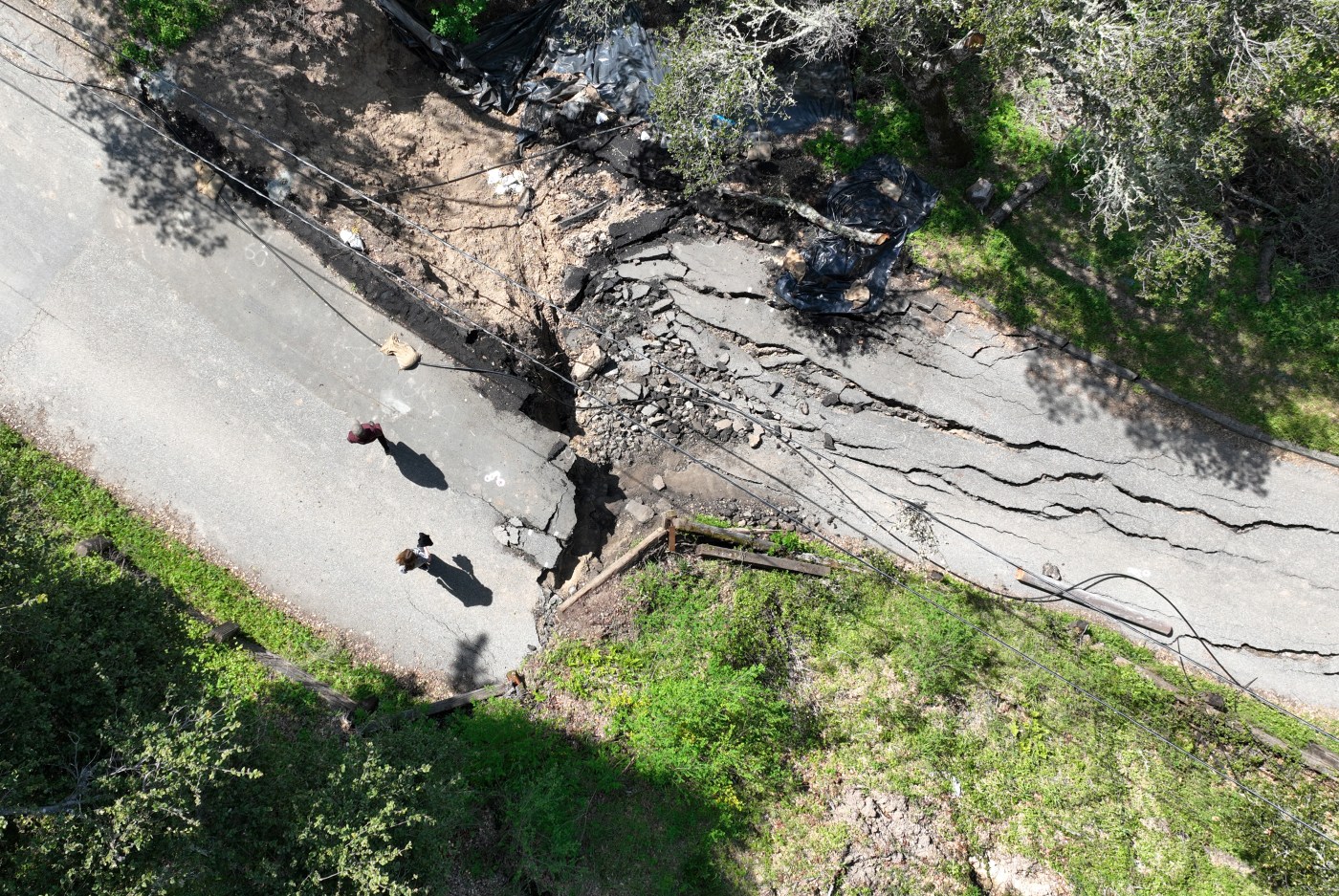Local officials are working to assess the status of a landslide on Mountain Charlie Road in the Santa Cruz Mountains as residents continue to contend with limited access to main roads to get to work and school.
Santa Cruz County’s Department of Public Works on April 12 secured $30,000 to conduct a geotechnical study and install equipment that will help them determine the rate of movement and characteristics of the slide from the inside. They said this effort will help county officials make the case that the slide is the result of heavy storms in the area last January, and as such should be eligible to receive the funds from the Federal Emergency Management Agency’s disaster declaration for those storms.
Steve Wiesner, assistant director of public works for the county, said his department’s short-term priorities are to continue studying the movement of the slide for the next one to two months and to wait for the slide to dry out and movement to come to a stop. This will allow them to get a sense of what repairs are needed and what those repairs might cost, he said.
“Once we have that data, and once everything kind of settles out and stops moving, then we can start to really look at what repair strategies are available to us,” Wiesner added.
But long-term concerns about finding funds for those repairs persist.
FEMA has issued several disaster declarations for the county in recent years that have unlocked hundreds of millions of dollars in federal aid, but the county has yet to receive the full amount of this aid. Among the disaster declarations is one in 2023 for heavy storms in the county. The declarations paved the way to securing roughly $74 million in federal funds to aid in the county’s relief efforts, but as of last December, the county had only received 12% of those funds.
As such, the county’s efforts to find funds for the Mountain Charlie Road slide have proven difficult given the county’s persistent debt, and Weisner said he’s “definitely concerned” about the possibility that the county won’t be able to identify a source of funding.
“I’m an optimist, but I’m also a realist,” Wiesner said. “The optimist in me wants to believe that funding sources will come forward, and that’s why we’re leaving no rocks unturned.”
If the county did have the funds to support repairs on the road immediately, the process would still take anywhere from six months to a year after the slide’s movement stops later this summer, Wiesner said.
He said the department of public works has been in close touch with US Rep. Jimmy Panetta, whose district includes residents in the area, about their efforts to secure funding.
“My office continues to work in close coordination with both Santa Cruz County and FEMA on assessments and appeals needed to secure federal support for the repair of Mountain Charlie Road,” Panetta said in a statement.
Community members are pitching in to help. Theresa Bond, a board member for the Los Gatos-Saratoga Union High School District where many Mountain Charlie Road residents attend school, visited the landslide in April to meet with residents and draft a report on the situation to the state department of education’s school facilities and transportation services division.
“Ensuring our students’ ability to travel to and from school safely is a top priority for the district, and we are hopeful that these new discussions will lead to the support and response they need,” Tanya De La Cruz, spokesperson for the district, said in a statement.
After storms hit throughout the state in February, Gov. Gavin Newsom requested a presidential major disaster declaration Santa Cruz County and other counties to be included in relief efforts. Though the request was approved in April, the slide will not be eligible to receive funding through the declaration, said Tiffany Martinez, communications officer for the county’s department of public works.
Meanwhile, residents of Mountain Charlie Road and the surrounding area remain frustrated with the one- to three-year timeline for repairs outlined by county officials.
Emotional toll
Debbie Robinson, who lives south of the landslide, said the limited mobility that the slide has imposed on the community has taken an emotional toll on residents, who live in unincorporated Santa Cruz County with Los Gatos addresses. She said it has especially affected kids who are having a hard time seeing their friends and focusing on extracurricular activities.
“Every morning when my daughter leaves to go to school, I worry about her getting across the slide safely and getting to school,” she said.
The slide has almost completely demolished a private driveway that leads to five houses, in addition to blocking a portion of Mountain Charlie Road. While residents have been able to park their cars on the other side of the slide and cross it by foot to get to their cars to drive to Los Gatos, where many attend school and work, the slide’s constant movement means that will likely change in the near future.
The safest alternative is a long drive in the wrong direction to Scotts Valley to eventually head north, which means a doubling or tripling of commute times.
“It’s frustrating that we still don’t have any answers,” Robinson said. “Obviously, the slide is still active so they can’t do repairs, but the timeline that we were given, one to three years, is just really stressful.”
Robinson, who has lived in the mountains for most of her life, said the situation has sparked conversations in her household about moving.
But even if they did decide to move, doing so would be almost impossible until the road is repaired because large vehicles like moving trucks would have no way of making it safely to her house. Residents have felt “trapped,” she said.
“It’s sad because I love living here and it’s a beautiful area, but at some point this is not sustainable for the long term,” she said.












